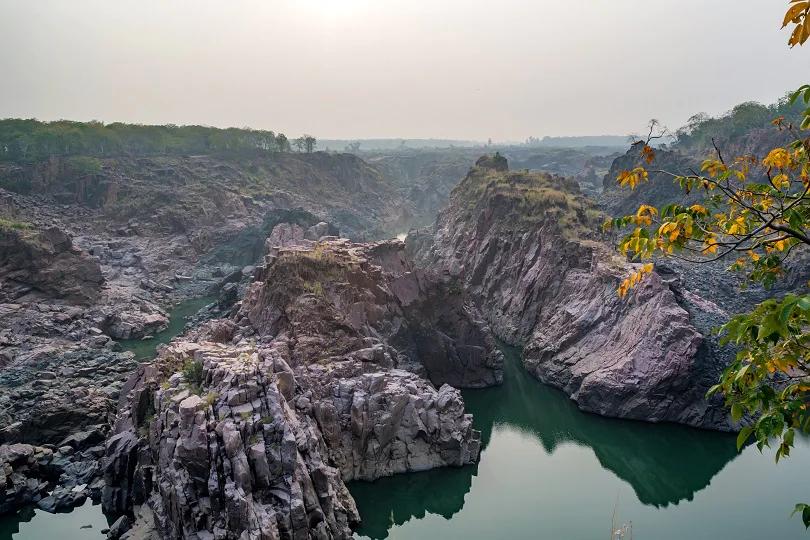

Raneh Falls, hidden away among the forests of Madhya Pradesh near Khajuraho Temple, is one of the most beautiful and mysterious spots in entire India. In spite of its jaw-dropping beauty, most Indians have barely heard of its name let alone having visited it. The Raneh Falls: Grand Canyon at Khajuraho is easily one of the most valuable hidden gems in the treasury of India.
Dubbed the Grand Canyon of India by the international tourists who have seen the Grand Canyon up close, the Raneh Falls boasts of an impressive kaleidoscopic view that isn’t available anywhere else. The Raneh Falls are so underrated that less than 10% of the tourists who come to Khajuraho to enjoy and marvel at the architecture of the place, carry on to this waterfall of Khajuraho which is situated nearby.


The ideal time to visit the Raneh Falls is the post-monsoon season when the Ken river has had a fresh inflow of rainwater as at other times almost all of its water is diverted away to meet the needs of the Bariyarpur Dam. As a result, the Ken River in Chhatarpur is almost always devoid of water, save for the post-monsoon season. The river Ken, being the primary provider of water for the falls, is an important factor to account for while planning a trip to the Raneh Falls.
The nearest rail-head is Mahoba situated at a distance of 75 km from the falls. Khajuraho airport is the nearest airport and is situated 22 km away. The place is well connected with the outside world via roads. Being situated near the Khajuraho temple, a large number of buses, cabs, and auto-rickshaws are available to make the trip to the Raneh Falls.
The entire canyon spans over a distance of a measly 5 km. But even in this very limited span, the canyon presents geological features that are just not available anywhere else in India. Even all over the world the intense change in depth of the canyon is not something which is seen commonly. The Grand Canyon is the only canyon that comes to mind while seeing the depth variation of the Raneh Falls canyon. At some points, the canyon takes a dip of around 50 m while there are depths that extend to just 5 m This intense depth variation gives rise to some amazing geographical features in the area which add to the thrill of the canyon. This depth variation is also the reason why nobody should visit the canyon during the monsoon months. One should only come post monsoons or even ideally during the winters when the water dries up and the magnificent canyon is laid bare to its last pebble for the world to gaze upon and admire.
Generally a particular region has one or a maximum of two igneous rock types due to the simple fact of binaries present in nature. Usually, the igneous rocks come in pairs when they are more than one in number like granite and dolomite, etc. but this place, in addition to the primary types, has 3 other rock types. The different igneous rocks give rise to an ethereal concoction of colours which can be found on the stones throughout the canyon. As a result we find the shades of red, brown, grey and even pink on the canyon walls which give the perfect touch to the picturesque views. This canyon is the only place in the entire continent of Asia which has five different kinds of igneous rocks which makes it a must watch for nature lovers. The five primary rocks are green dolomite, black basalt, brown quartz, red Jasper and finally pink coloured granite.
A few kilometers down the river Ken is the sanctuary that is dedicated towards the protection of Gharials which live in these waters. This sanctuary is situated in the region of the mixed flow of the rivers Ken and Khudar. Gharials, or the fish-eating variety of water crocodiles, are reserved in this sanctuary. If you are lucky, you can spot a Gharial chilling on the banks of the river. The primary identity of a Gharial is its sharp and narrow snout in comparison to the heavy jaws of alligators. This sanctuary is also the home to monkeys, nilgai and other varieties of deer.
Due to the extensive canyon formation, the river finds it difficult to navigate the course and has to continuously drop down from higher elevations, giving birth to small waterfalls as a result. The primary attraction is the biggest waterfall which is fed directly by River Ken. The small waterfalls form numerous gorges which enhance the scenic value of this place.
Due to the suggested building of another dam on the river, the Raneh Falls may disappear in the future in spite of already having two dams that eat up much of the waterfall. The central falls are only found in post-monsoon because at other times the river remains dry. All the more reason for you to plan a trip soon!
Most people have no idea that this waterfall and canyon exist. So go pack your bags and take a tour so that you can experience firsthand the magnanimity and majestic views of and from the waterfalls and top of the canyons. This should definitely be an experience worth cherishing for years to come!
Noida, with its vibrant culinary scene, offers a plethora of options for dessert lovers craving…
Embarking on a journey? Make your travels more convenient and enjoyable with the latest accessories…
As the temperature drops and the chilly winds start to blow, staying warm and healthy…
Travel photography is not just about capturing moments; it's about immortalising experiences, landscapes, and the…
Embarking on a solo adventure can be exhilarating, offering the freedom to explore new destinations…
Business travel often entails tight schedules and hectic itineraries, leaving little room for packing mishaps…